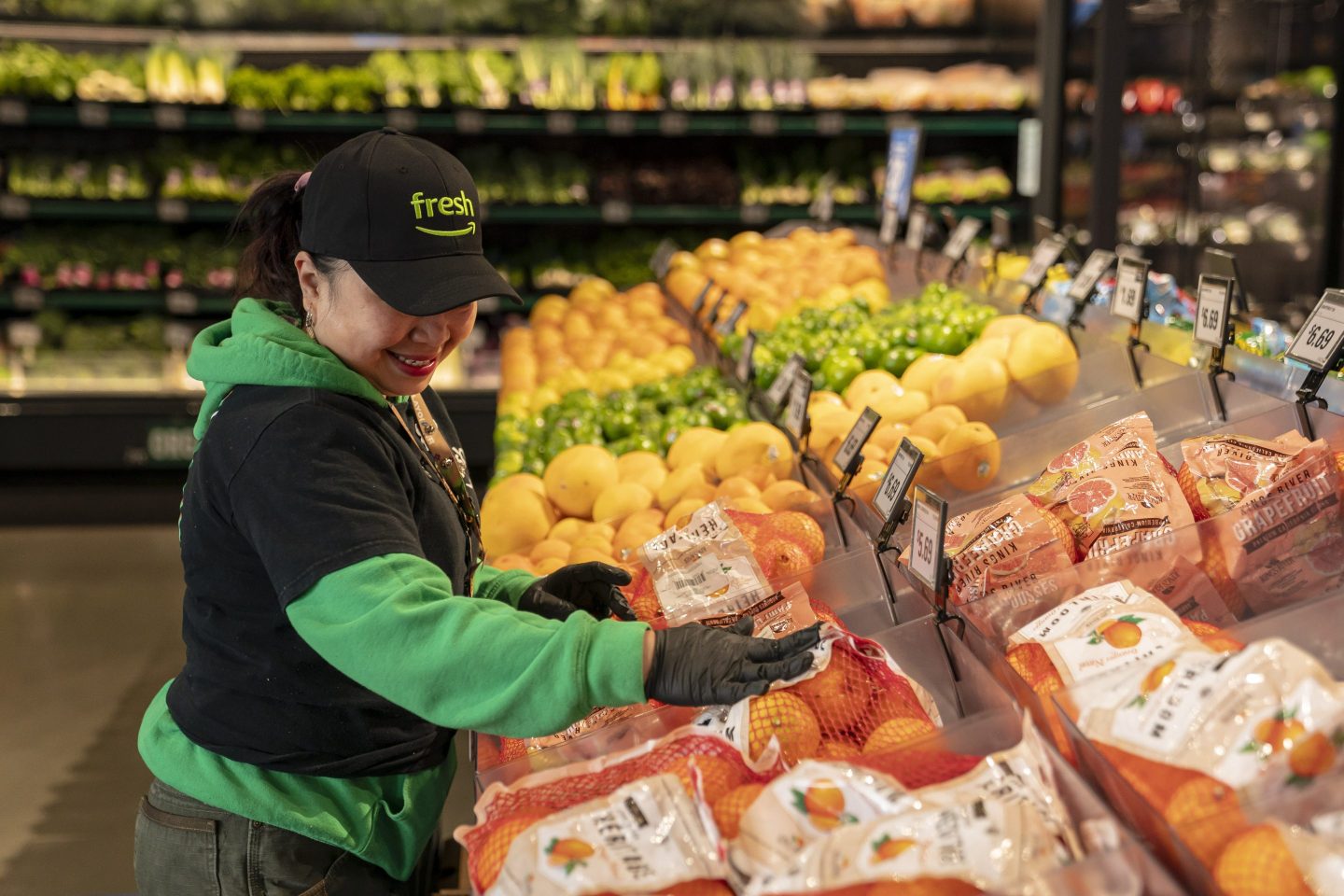
緊隨沃爾瑪(Walmart)和塔吉特(Target)的腳步,亞馬遜生鮮(Amazon Fresh)剛剛成為最新一家削減數(shù)千種商品成本的大型零售商,扭轉(zhuǎn)了多年來因通貨膨脹導致的價格上漲趨勢,以吸引心懷不滿的顧客回流。
亞馬遜旗下的子公司亞馬遜生鮮周四宣布,將把每周輪換的4000種食品雜貨的成本削減至多30%。折扣將適用于國內(nèi)品牌和亞馬遜自營品牌。
亞馬遜生鮮全球副總裁克萊爾·彼得斯在一份聲明中表示:“無論是在實體店還是在網(wǎng)上,增加數(shù)千種商品的每周優(yōu)惠,擴大Prime會員優(yōu)惠在亞馬遜生鮮的覆蓋范圍,這只是我們繼續(xù)投資于具有競爭力的價格和為所有顧客提供優(yōu)惠的一種方式。”
上周,許多零售商紛紛推出必需品折扣:塔吉特做出了與亞馬遜類似的承諾,稱將下調(diào)包括尿布和寵物食品在內(nèi)的5000種商品的價格。今年2月,這家零售商推出了“dealworthy”折扣品牌,包括400種家庭用品和必需品,其中大部分商品的價格不到10美元。沃爾瑪還表示,將降低7000種商品的成本,價格回調(diào)幅度達45%。阿爾迪(Aldi)和克羅格(Kroger)也都采取了降低食品雜貨價格的措施。
在此之前,截至4月份,持續(xù)的通貨膨脹使食品雜貨成本同比上漲了1.1%。這一數(shù)字較3月份下降了0.1%,遠低于餐廳食品價格4.1%的同比漲幅,這讓零售商有機會利用消費者對食品雜貨日益依賴的機會。
沃爾瑪首席執(zhí)行官董明倫本月對分析師表示:“一如既往,我們將在價格上領(lǐng)先,并控制利潤率。”
零售商感受到壓力
大型零售商降價并不是在艱難時期向顧客拋出橄欖枝的利他之舉。由于消費者難以忍受高昂的價格,零售商的銷售疲軟。塔吉特公布凈銷售額較上年同期下降3.1%,季度可比銷售額下降3.7%,連續(xù)第四個季度出現(xiàn)下滑。盡管沃爾瑪?shù)臉I(yè)績持續(xù)飆升,但其6%的收入增長主要歸功于其在電子商務領(lǐng)域的成功和富裕的客戶群,后者在其受眾中所占的比例越來越大。
這一趨勢在快餐業(yè)也得到了延續(xù),麥當勞(McDonald’s)、溫迪漢堡(Wendy’s)和漢堡王(Burger King)都宣布推出餐食優(yōu)惠。此前的收益報告顯示,消費者正在失去對高價快餐的興趣,包括18美元的巨無霸套餐和價格飆升的威脅。
此外,經(jīng)濟政策組織Groundwork Collaborative的執(zhí)行董事林賽·歐文斯認為,零售商最初提價的決定不能完全歸咎于通貨膨脹。她對《華盛頓郵報》表示,在運營成本增加的同時,企業(yè)的利潤率實際上也在增加。美國聯(lián)邦貿(mào)易委員會(Federal Trade Commission)2024年3月的一份報告發(fā)現(xiàn),2023年前三季度,食品和飲料的零售收入比總成本增長了7%,這表明雜貨店提價的決定不僅僅是通貨膨脹、供應鏈中斷或大宗商品價格上漲的結(jié)果。
歐文斯說:“你所看到的是,這些公司實際上是通過將上漲的成本全部轉(zhuǎn)嫁給了消費者,然后再爭取更多的利潤來實現(xiàn)這一目標的。”(財富中文網(wǎng))
譯者:中慧言-王芳
緊隨沃爾瑪(Walmart)和塔吉特(Target)的腳步,亞馬遜生鮮(Amazon Fresh)剛剛成為最新一家削減數(shù)千種商品成本的大型零售商,扭轉(zhuǎn)了多年來因通貨膨脹導致的價格上漲趨勢,以吸引心懷不滿的顧客回流。
亞馬遜旗下的子公司亞馬遜生鮮周四宣布,將把每周輪換的4000種食品雜貨的成本削減至多30%。折扣將適用于國內(nèi)品牌和亞馬遜自營品牌。
亞馬遜生鮮全球副總裁克萊爾·彼得斯在一份聲明中表示:“無論是在實體店還是在網(wǎng)上,增加數(shù)千種商品的每周優(yōu)惠,擴大Prime會員優(yōu)惠在亞馬遜生鮮的覆蓋范圍,這只是我們繼續(xù)投資于具有競爭力的價格和為所有顧客提供優(yōu)惠的一種方式。”
上周,許多零售商紛紛推出必需品折扣:塔吉特做出了與亞馬遜類似的承諾,稱將下調(diào)包括尿布和寵物食品在內(nèi)的5000種商品的價格。今年2月,這家零售商推出了“dealworthy”折扣品牌,包括400種家庭用品和必需品,其中大部分商品的價格不到10美元。沃爾瑪還表示,將降低7000種商品的成本,價格回調(diào)幅度達45%。阿爾迪(Aldi)和克羅格(Kroger)也都采取了降低食品雜貨價格的措施。
在此之前,截至4月份,持續(xù)的通貨膨脹使食品雜貨成本同比上漲了1.1%。這一數(shù)字較3月份下降了0.1%,遠低于餐廳食品價格4.1%的同比漲幅,這讓零售商有機會利用消費者對食品雜貨日益依賴的機會。
沃爾瑪首席執(zhí)行官董明倫本月對分析師表示:“一如既往,我們將在價格上領(lǐng)先,并控制利潤率。”
零售商感受到壓力
大型零售商降價并不是在艱難時期向顧客拋出橄欖枝的利他之舉。由于消費者難以忍受高昂的價格,零售商的銷售疲軟。塔吉特公布凈銷售額較上年同期下降3.1%,季度可比銷售額下降3.7%,連續(xù)第四個季度出現(xiàn)下滑。盡管沃爾瑪?shù)臉I(yè)績持續(xù)飆升,但其6%的收入增長主要歸功于其在電子商務領(lǐng)域的成功和富裕的客戶群,后者在其受眾中所占的比例越來越大。
這一趨勢在快餐業(yè)也得到了延續(xù),麥當勞(McDonald’s)、溫迪漢堡(Wendy’s)和漢堡王(Burger King)都宣布推出餐食優(yōu)惠。此前的收益報告顯示,消費者正在失去對高價快餐的興趣,包括18美元的巨無霸套餐和價格飆升的威脅。
此外,經(jīng)濟政策組織Groundwork Collaborative的執(zhí)行董事林賽·歐文斯認為,零售商最初提價的決定不能完全歸咎于通貨膨脹。她對《華盛頓郵報》表示,在運營成本增加的同時,企業(yè)的利潤率實際上也在增加。美國聯(lián)邦貿(mào)易委員會(Federal Trade Commission)2024年3月的一份報告發(fā)現(xiàn),2023年前三季度,食品和飲料的零售收入比總成本增長了7%,這表明雜貨店提價的決定不僅僅是通貨膨脹、供應鏈中斷或大宗商品價格上漲的結(jié)果。
歐文斯說:“你所看到的是,這些公司實際上是通過將上漲的成本全部轉(zhuǎn)嫁給了消費者,然后再爭取更多的利潤來實現(xiàn)這一目標的。”(財富中文網(wǎng))
譯者:中慧言-王芳
Amazon Fresh just became the latest big-box retailer to cut costs on thousands of items, following in the footsteps of Walmart and Target in reversing course on years of inflation-induced price hikes in a bid to lure back disgruntled customers.
The company’s Amazon Fresh subsidiary announced Thursday it will slash the costs of 4,000 weekly rotating grocery products by up to 30%. The discounts will apply to both national and Amazon’s store brands.
“Increasing our Weekly Deals across thousands of items and expanding the reach of Prime Savings at Amazon Fresh is just one way that we’re continuing to invest in competitive pricing and savings for all of our customers—both in-store and online,” Amazon Fresh worldwide vice president Claire Peters said in a statement.
Last week saw an onslaught of retailers offering discounts on essential items: Target made a similar promise as Amazon’s, saying it would cut the prices of 5,000 items including diapers and pet food. The retailer rolled out its “dealworthy” discount brand in February, introducing 400 household and essential products mostly under $10. Walmart also said it would lower costs of 7,000 items, a 45% increase in price rollbacks. Aldi and Kroger both made moves to lower grocery prices as well.
These price cuts come after persistent inflation raised the cost of groceries 1.1% year over year as of April. That’s down 0.1% from March and significantly less than the 4.1% year-over-year price increase for food from restaurants, leaving retailers with an opportunity to take advantage on consumers’ increased reliance on groceries.
“We’re going to lead on price, and we’re going to manage our [profit] margins, and we’re going to be the Walmart that we’ve always been,” Walmart CEO Doug McMillon told analysts this month.
Retailers feel the pressure
Big-box stores lowering prices wasn’t an altruistic move to throw customers a bone during tough times. Retailers have suffered from weak sales due to customers’ struggle with high prices. Target reported a 3.1% drop in net sales from a year ago and a 3.7% quarterly dip in comparable sales, marking its fourth consecutive quarter of declines. Though Walmart has continued to soar, it owes much of its 6% revenue growth to its e-commerce successes and wealthy customer base, the latter of which makes up a growing chunk of its audience.
This trend has continued in fast food, with McDonald’s, Wendy’s, and Burger King all announcing meal deals following earnings reports that suggest customers are losing their taste for high-priced fast food, including $18 Big Mac meals and threats of surge pricing.
Moreover, retailers’ decision to hike prices in the first place can’t all be attributed to inflation, Lindsay Owens, executive director of economic policy group Groundwork Collaborative, argued. She told the?Washington Post that companies actually increased their margins in times of increased operating costs. A March 2024 Federal Trade Commission report found retail revenue for food and beverages increased 7% above total costs in the first three quarters of 2023, indicating that grocery stores’ decision to raise prices wasn’t just a result of inflation, supply-chain disruptions, or the rising prices of commodities.
“What you see is that’s effectively made possible by companies who are passing along their rising costs in full but then going for more,” Owens said.






